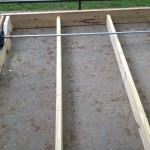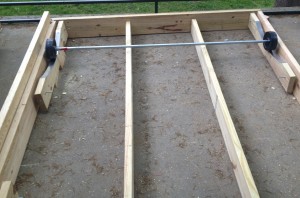Designers: Austin Brockway and Justin Watson
Client Coordinator: Sally McMurry, teacher
INTRODUCTION
Our client Abigail is a playful 5-year-old elementary student with cerebral palsy. She has little head and neck control and limited left arm control. She enjoys lights, sounds, and rocking motions. She enjoys the swings and other activities at the separate accessible playground at her school. Her teacher noted that she is most engaged when on the same level as her peers. However, there is no equipment for her peers to use at the accessible playground, and there is no accessible equipment at the general population playground. Therefore, she can visit the general playground but just sits in her stroller and watches the other students.
We designed and built an accessible glider that motivates Abigail and her peers to play together on the playground. It incorporates the rocking motions that she enjoys, and her peers activate these motions by pulling on a rope. It is safe and accessible to Abigail and other children who use wheelchairs or strollers.
STATEMENT OF IMPACT
This device gives our client the ability to interact with her peers on the playground. It is safe and accessible and it is a fun activity for both kids with disabilities and for the rest of the school population.
TECHNICAL DESCRIPTION
Our device is an enclosed horizontal glider accessible to children with and without disabilities. The glider consists of a platform, base, and ramp. The platform moves back and forth along the base, on a set of tracks with a free-rolling axle between the base and the platform. To initiate motion, students pull on a horizontal rope positioned along one wall of the glider, free of pinch points. The access ramp is on one side of the platform so that students in wheelchairs and strollers can get on and off easily.
The platform was constructed similar to a deck for a house. We built a 6’x8’ frame and slotted three additional 2”x8” joists into the frame. We then attached fifteen 1”x6” decking boards across it horizontally to make the “deck”. We installed four 4”x4” posts in each corner, and then built up 3’ tall walls using similar decking materials. The platform was built using Alkaline Copper Quaternary (ACQ) pressure treated softwood, so that the lumber will be both durable but safe for children to play on.
The gliding motion of our device comes from two parallel sets of wheels running independently on two “almond-shaped” tracks. The base of the glider remains stationary, but when the platform is displaced horizontally to one side, the platform and both sets of wheels move in that direction until the wheels approach the top edge of the slotted track. At this point, because of the “almond” shape, gravity acts as restoring force and the platform and wheels begin to move in the opposite direction.
The slots are each two feet in arc length and were banded with metal to increase durability. The wheels are 6” in diameter and are composed of solid Soft Rubber (non-marking) with a 1 3/16” bore, on opposite ends of a 1 3/16” diameter galvanized metal axle.
To initiate movement, students pull on a rope along one edge of the glider. This rope stretches between two pillars, each located near one corner of the glider when at rest. This design eliminates pinch points between the glider and the stationary pillar and ensures that there are no rope enclosures greater than 6” in diameter, for risk of accidental injury or strangulation. It requires little force to activate and maintain this motion, so children can sustain this activity without adult assistance.
The glider is compliant to Americans With Disabilities Act (ADA) guidelines. There is a wheelchair ramp that provides access to the glider. Up to two wheelchairs can be secured to the platform, using tie down straps and blocks for the wheels.



University Operator: (919) 962-2211 | © 2024 The University of North Carolina at Chapel Hill |